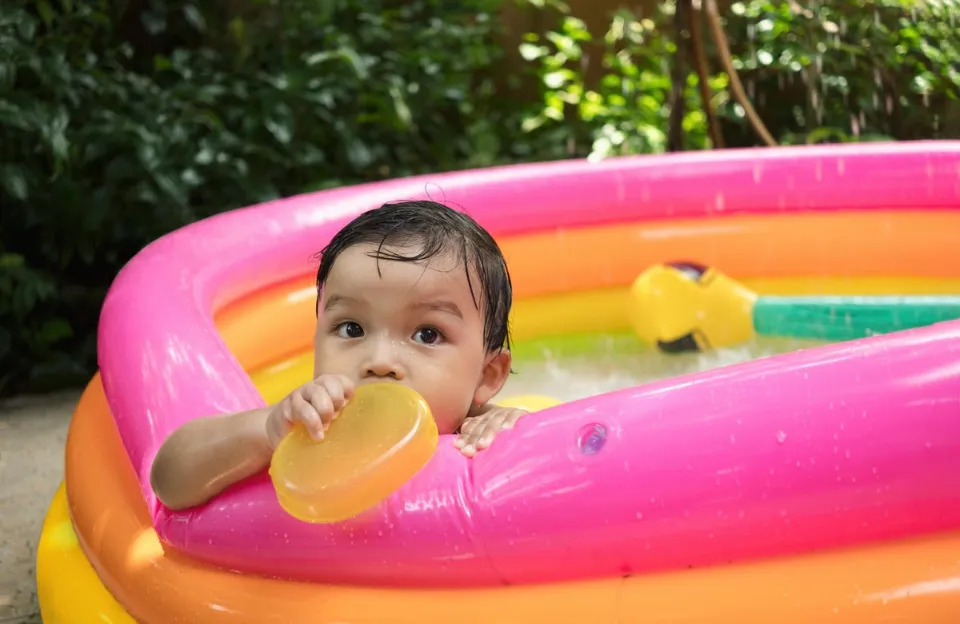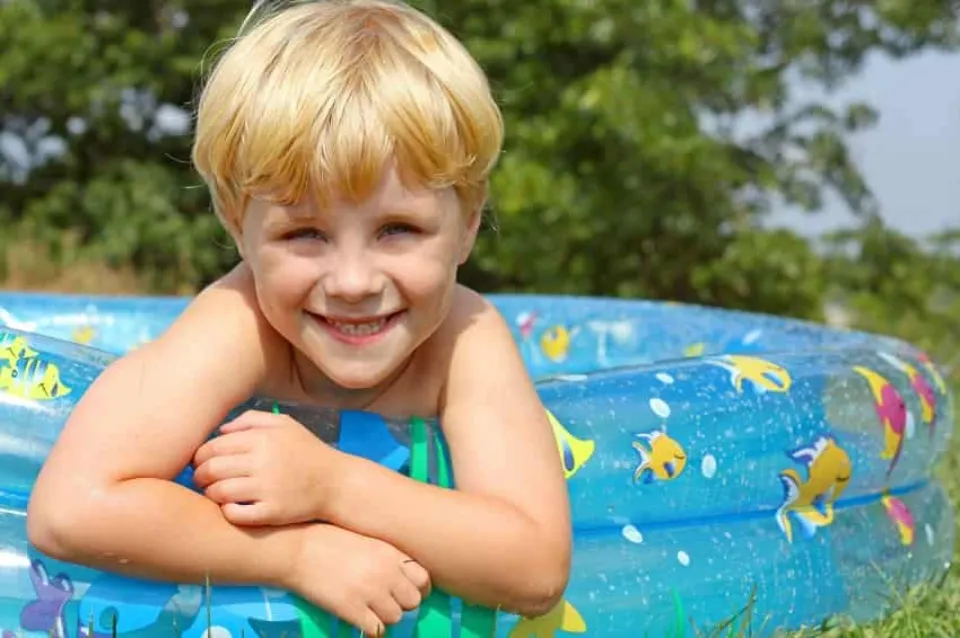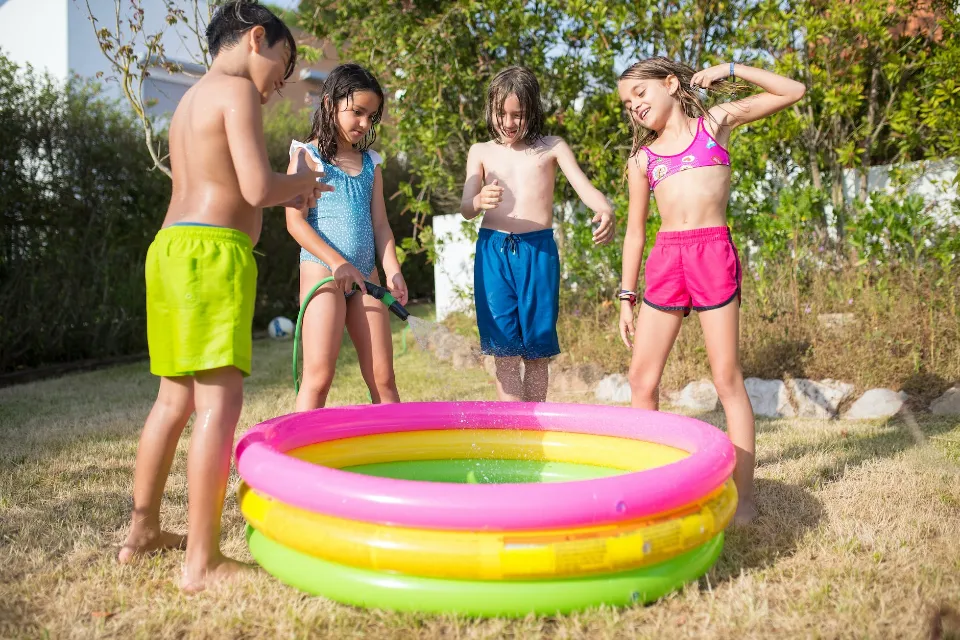How To Clean An Inflatable Kiddie Pool – Step by Step Guide 2023
Because most inflatable pools don’t include a pump and filter, they typically get dirty more quickly than a regular pool. The water may become murky or an odd shade of green. And there may be some slimy residue that is accumulating. Swimming in slimy, bacterial-filled water is not something anyone wants to do.
Every few days, you should refill an inflatable pool after draining the water and cleaning the lining with a cleaning agent.
Learn everything you need to know about cleaning an inflatable pool by referring to this guide.

Steps to Clean An Inflatable Pool
The steps necessary to thoroughly clean an inflatable pool from top to bottom are listed below. You might only need to properly treat the water in a sizable inflatable pool with a pump in order to get the pool clean.
Step 1: Drain Water
First, empty the pool completely of water. You can tell you need to clean the pool because it feels slimy and the water has started to turn green or cloudy.
Step 2: Dry the Pool
Try your best to thoroughly dry the pool with a dry towel or rag after you have completely drained it. You shouldn’t be concerned just yet if the pool has mildew or feels slimy. Get the remaining water out of the pool; you don’t need to wipe off all the dirt.
Step 3: Cleaning Solution
You could try using a sanitary wipe made by Lysol, but I’ve found that you need a lot of them to thoroughly clean the pool. Instead, I make a cleaning solution by adding a little bleach to a bucket of water. Workable alternatives include any spray bottle of kitchen or bathroom cleaner. Something with bleach or a sanitizer in it is what I advise.
Step 4: Scrub Lining
You can scrub the pool with soapy water to remove any dirt or slimy buildup on the surface before using bleach or another cleaning solution. You might be able to get away with simply cleaning the pool this way with soapy water if it wasn’t all that filthy to begin with. To be absolutely certain, I still like to give everything a quick wipe down with bleach water.
Don’t forget to put on gloves as you begin to scrub the pool’s walls with a rag and your cleaning solution. Remove any mildew or grimy film you feel on the material by cleaning the inflatable pool’s entire surface.
Step 5: Rinse Out Pool
Rinse the pool with a garden hose or a bucket of water. Before filling the pool with water, you should rinse out the pool completely. This may require a couple of cycles.

Step 6: Refill Water
You might need to repeat the scrub and rinse steps if the material inside the pool still feels slimy or has a discolored film on it. You can refill the pool with fresh water once it has been thoroughly cleaned and rinsed.
Depending on your usage and how much water you use, you might need to do this every 2-4 days. Follow the “keep a pool clean” advice listed below to reduce the amount of pool maintenance you need to perform.
How Can You Use Chemicals Safely in An Inflatable Pool?
Chlorine can be used in inflatable pools; as long as it is diluted to a safe level, it won’t harm the lining or endanger your health. You’ll need a skimmer to clear the pool of any debris if you plan to use chlorine.
Large inflatable pools can be expensive to drain for cleaning, and you might not be able to easily direct the water down into the sewer, which could result in flooding your garden and killing the grass.
It is preferable to use chlorine and a pH balancer to keep large pools clean and prevent the water from becoming too acidic for swimming.
As long as you adhere to the instructions, using chlorine is very easy. You risk causing skin damage if you dilute it insufficiently. It won’t work if you dilute it too much. Typically, you want to use 1 part chlorine to 100 parts water.
The water will still become dirty because you won’t be completely draining it because debris will fall into the water and remain there. Therefore, if you plan to use chlorine, be sure to also buy a skimming net.
How Often Should You Change Inflatable Pool Water?
You should change the water in your inflatable pool every few days, or at most once a week, if you’re not using chemicals to clean the water. Every two to three months, even chlorine-treated pools should be drained and filled again.
If pool water is left unattended for too long, bacteria will probably begin to accumulate. Yes, chlorine will kill most of it, but it’s best to completely freshen the water and start over at least four times per year because chlorine is more potent in fresh water.
What is the Importance of Cleaning An Inflatable Pool?
You should keep your inflatable pool clean for a variety of reasons, but your comfort is the most crucial. It is much preferable to swim or unwind in clear, clean water rather than having to contend with scum-covered or water that is slightly slimy and makes you feel dirty.
Health-wise, it can also be detrimental, especially if you accidentally ingest some. Cleaning the pool ensures that the water is always safe for you, preventing eye infections or even diarrhea.
Finally, dirty water can eventually stain the lining of an inflatable pool and cause damage. Cleaning it keeps it intact so that it lasts longer, provided you don’t use harsh chemicals or rough scourers.
Final Words
An inflatable pool should always be kept as spotless as possible whether you already own one or plan to purchase one. Aside from being unpleasant, dirty water can also spread disease.
For larger pools, chemical cleaning makes sense, but for smaller ones, simply draining the pool, cleaning the sides, and starting over is simpler and less abrasive.
Frequently Asked Questions
What Are the Essential Tools in Cleaning An Inflatable Pool?
You’ll need a soft sponge and some liquid detergent to clean an inflatable pool. Depending on how dirty the pool is, you might also want some pool cleaner. Once the pool has been scrubbed, a hose is a helpful tool for rinsing it.
How to Keep a Kiddie Pool Clean Without Chemicals?
A kiddie pool only needs to be drained every few days, scrubbed with water and a small amount of liquid detergent, and then refilled with fresh water to be cleaned without endangering the skin of children who have sensitive skin.
